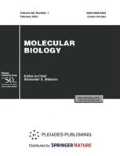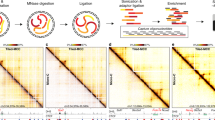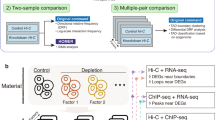Abstract
ZNF143 is a ubiquitously expressed transcription factor conserved in vertebrates and might regulate the expression of numerous genes. But its function in mediating chromatin interactions remains elusive. By integrated analysis of public datasets, we provided evidence that a majority of ZNF143 binding sites (BSs) were involved in CTCF-mediated chromatin interaction networks (CTCF-CINs) by overlapping with cohesin-BSs and CTCF-BSs. We further showed that only a very few CTCF-CINs were associated with ZNF143 alone, whereas those associated with ZNF143 and cohesin simultaneously were highly overlapped with constitutive, conserved CTCF-BSs and enriched at boundaries of chromatin topologically associating domains. These observations implicate that as an important partner of CTCF, ZNF143 helps it establish the conserved chromatin structure by cooperating with cohesin.
Similar content being viewed by others
Abbreviations
- BS:
-
binding site
- CIN:
-
chromatin interaction network
- TAD:
-
topologically associating domain
References
Schuster C., Myslinski E., Krol A., Carbon P. 1995. Staf, a novel zinc finger protein that activates the RNA polymerase III promoter of the selenocysteine tRNA gene. EMBO J. 14, 3777–3787.
Ngondo-Mbongo R.P., Myslinski E., Aster J.C., Carbon P. 2013. Modulation of gene expression via overlapping binding sites exerted by ZNF143, Notch1 and THAP11. Nucleic Acids Res. 41, 4000–4014.
Izumi H., Yasuniwa Y., Akiyama M., Yamaguchi T., Kuma A., Kitamura N., Kohno K. 2011. Forced expression of ZNF143 restrains cancer cell growth. Cancers. 3, 3909–3920.
Chia N.Y., Chan Y.S., Feng B., Lu X., Orlov Y.L., Moreau D., Kumar P., Yang L., Jiang J., Lau M.S., Huss M., Soh B.S., Kraus P., Li P., Lufkin T., et al. 2010. A genome-wide RNAi screen reveals determinants of human embryonic stem cell identity. Nature. 468, 316–320.
Schaub M., Myslinski E., Schuster C., Krol A., Carbon P. 1997. Staf, a promiscuous activator for enhanced transcription by RNA polymerases II and III. EMBO J. 16, 173–181.
Mercer T.R., Edwards S.L., Clark M.B., Neph S.J., Wang H., Stergachis A.B., John S., Sandstrom R., Li G., Sandhu K.S., Ruan Y., Nielsen L.K., Mattick J.S., Stamatoyannopoulos J.A. 2013. DNase I-hypersensitive exons colocalize with promoters and distal regulatory elements. Nat. Genet. 45, 852–859.
Liang J., Lacroix L., Gamot A., Cuddapah S., Queille S., Lhoumaud P., Lepetit P., Martin P.G., Vogelmann J., Court F., Hennion M., Micas G., Urbach S., Bouchez O., Nollmann M., et al. 2014. Chromatin immunoprecipitation indirect peaks highlight long-range interactions of insulator proteins and Pol II pausing. Mol. Cell. 53, 672–681.
Gerstein M.B., Kundaje A., Hariharan M., Landt S.G., Yan K.K., Cheng C., Mu X.J., Khurana E., Rozowsky J., Alexander R., Min R., Alves P., Abyzov A., Addleman N., Bhardwaj N., et al. 2012. Architecture of the human regulatory network derived from ENCODE data. Nature. 489, 91–100.
Xie D., Boyle A.P., Wu L., Zhai J., Kawli T., Snyder M. 2013. Dynamic trans-acting factor colocalization in human cells. Cell. 155, 713–724.
Ong C.T., Corces V.G. 2014. CTCF: An architectural protein bridging genome topology and function. Nat. Rev. Genet. 15, 234–246.
Gomez-Diaz E., Corces V.G. 2014. Architectural proteins: Regulators of 3D genome organization in cell fate. Trends Cell Biol. 24, 703–711.
Holwerda S.J., de Laat W. 2013. CTCF: The protein, the binding partners, the binding sites and their chromatin loops. Philos. Trans. R. Soc. Lond. B. Biol. Sci. 368, 20120369.
ENCODE Project Consortium. 2012. An integrated encyclopedia of DNA elements in the human genome. Nature. 489, 57–74.
Bailey T.L., Boden M., Buske F.A., Frith M., Grant C.E., Clementi L., Ren J., Li W.W., Noble W.S. 2009. MEME SUITE: Tools for motif discovery and searching. Nucleic Acids Res. 37, W202–W208.
Merkenschlager M., Odom D.T. 2013. CTCF and cohesin: Linking gene regulatory elements with their targets. Cell. 152, 1285–1297.
Michaud J., Praz V., James Faresse N., Jnbaptiste C.K., Tyagi S., Schutz F., Herr W. 2013. HCFC1 is a common component of active human CpG-island promoters and coincides with ZNF143, THAP11, YY1, and GABP transcription factor occupancy. Genome Res. 23, 907–916.
Vinckevicius A., Parker J.B., Chakravarti D. 2015. Genomic determinants of THAP11/ZNF143/HCFC1 complex recruitment to chromatin. Mol. Cell. Biol. 35, 4135–4146.
Bailey S.D., Zhang X., Desai K., Aid M., Corradin O., Cowper-Sal Lari R., Akhtar-Zaidi B., Scacheri P.C., Haibe-Kains B., Lupien M. 2015. ZNF143 provides sequence specificity to secure chromatin interactions at gene promoters. Nat. Commun. 2, 6186.
Guo Y., Gifford D.K. 2015. Modular combinatorial binding among human trans-acting factors reveals direct and indirect factor binding. bioRxiv. doi http://dxdoiorg/doi 10.1101/02795310.1101/027953
Zhao Z., Tavoosidana G., Sjolinder M., Gondor A., Mariano P., Wang S., Kanduri C., Lezcano M., Sandhu K.S., Singh U., Pant V., Tiwari V., Kurukuti S., Ohlsson R. 2006. Circular chromosome conformation capture (4C) uncovers extensive networks of epigenetically regulated intra- and interchromosomal interactions. Nat. Genet. 38, 1341–1347.
Dekker J., Rippe K., Dekker M., Kleckner N. 2002. Capturing chromosome conformation. Science. 295, 1306–1311.
Botta M., Haider S., Leung I.X., Lio P., Mozziconacci J. 2010. Intra- and inter-chromosomal interactions correlate with CTCF binding genome wide. Mol. Syst. Biol. 6, 426.
Handoko L., Xu H., Li G., Ngan C.Y., Chew E., Schnapp M., Lee C.W., Ye C., Ping J.L., Mulawadi F., Wong E., Sheng J., Zhang Y., Poh T., Chan C.S., et al. 2011. CTCF-mediated functional chromatin interactome in pluripotent cells. Nat. Genet. 43, 630–638.
Dixon J.R., Selvaraj S., Yue F., Kim A., Li Y., Shen Y., Hu M., Liu J.S., Ren B. 2012. Topological domains in mammalian genomes identified by analysis of chromatin interactions. Nature. 485, 376–380.
Sexton T., Yaffe E., Kenigsberg E., Bantignies F., Leblanc B., Hoichman M., Parrinello H., Tanay A., Cavalli G. 2012. Three-dimensional folding and functional organization principles of the Drosophila genome. Cell. 148, 458–472.
Mathelier A., Zhao X., Zhang A.W., Parcy F., Worsley- Hunt R., Arenillas D.J., Buchman S., Chen C.Y., Chou A., Ienasescu H., Lim J., Shyr C., Tan G., Zhou M., Lenhard B., et al. 2014. JASPAR 2014: An extensively expanded and updated open-access database of transcription factor binding profiles. Nucleic Acids Res. 42, D142–D147.
Hou C., Dale R., Dean A. 2010. Cell type specificity of chromatin organization mediated by CTCF and cohesin. Proc. Natl. Acad. Sci. U. S. A. 107, 3651–3656.
Ren L., Wang Y., Shi M., Wang X., Yang Z., Zhao Z. 2012. CTCF mediates the cell-type specific spatial organization of the Kcnq5 locus and the local gene regulation. PLoS ONE. 7 (2), e31416.
Ren L., Shi M., Wang Y., Yang Z., Wang X., Zhao Z. 2012. CTCF and cohesin cooperatively mediate the cell-type specific interchromatin interaction between Bcl11b and Arhgap6 loci. Mol. Cell. Biochem. 360, 243–251.
Heidari N., Phanstiel D.H., He C., Grubert F., Jahanbanian F., Kasowski M., Zhang M.Q., Snyder M.P. 2014. Genome-wide map of regulatory interactions in the human genome. Genome Res. 24, 1905–1917.
Author information
Authors and Affiliations
Corresponding authors
Additional information
Published in Russian in Molekulyarnaya Biologiya, 2016, Vol. 50, No. 3, pp. 496–503.
The article is published in the original.
Rights and permissions
About this article
Cite this article
Ye, BY., Shen, WL., Wang, D. et al. ZNF143 is involved in CTCF-mediated chromatin interactions by cooperation with cohesin and other partners. Mol Biol 50, 431–437 (2016). https://doi.org/10.1134/S0026893316030031
Received:
Accepted:
Published:
Issue Date:
DOI: https://doi.org/10.1134/S0026893316030031




